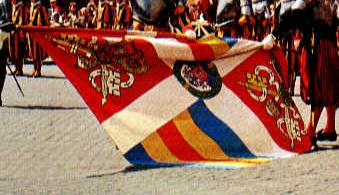
Last modified: 2004-09-18 by phil nelson
Keywords: flags | ground | salute | vailing |
Links: FOTW homepage |
search |
disclaimer and copyright |
write us |
mirrors

See also:
I noticed that the regiment present (I believe it is the RCR, the Royal Canadian Regiment), had its flag on the ground when the Governor-General walked by. Being taught that a flag is never to touch the ground, can anybody tell me whether this is military practice?
Rich Hansen July 1999
That was probably the regimental colour of either The Governor General's Foot Guards or The Canadian Grenadier Guards (these two regiments do most of the ceremonial parading on Parliament Hill). For guards regiments, the National Flag with one of the company badges on the maple leaf forms the basis for the regimental colour. I can't remember what the Queen's colours look like. Are they crimson with the royal crest?
This touching of flags to the ground as a salute is also done on Remembrance Day: the flags carried by the veterans are slowly lowered to the ground while "The Last Post" is being played; they remain there during the moment of silence and the lament; then they are quickly raised during "Reveille".
Dean Tiegs, 04 July 1999
The lowering of flags to the ground in salute goes back to at least the late 16th century, and used to be called "vailing". On the march the flag is lowered perpendicular to the body of the ensign (flag bearer). Standing troops lower their flag so that the pike touches the ground, and this is usually done with a flourish so that the flag drapes flat on the ground. The only modern concession the British have made is for the ensign to loosely roll the flag on the pike if the ground is wet in order to minimise soiling.
This is probably the m